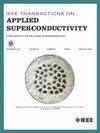Preliminary Assessment of a Highly Flexible HTS Drive for Electric Aircraft
IF 1.7
3区 物理与天体物理
Q3 ENGINEERING, ELECTRICAL & ELECTRONIC
引用次数: 0
Abstract
The push for the Energy Transition and the electrification of emerging applications, particularly those that already include cryogenics, has stimulated new developments in electric machines with high-temperature superconducting (HTS) materials in their components. Electric aircraft enabled by HTS-based systems, such as motors and energy distribution cables, are highlighted among those applications. In this context, there is an urgent need for machines with specific powers ranging from 15 to 30 kW/kg, which can leverage the inherent compactness and low weight of HTS motors. This work presents an electromechanical drive built by an axial-flux type motor with an HTS rotor, where the latter uses HTS REBCO tapes. The drive enables the electronic changing of the number of magnetic poles generated by a double stator with conventional windings. Consequently, the rotor must dynamically reconfigure its distribution of currents in the tapes to adapt to different numbers of poles. The prototype of the polyphase power electronics converter for the drive is also introduced. It allows for generating 24 voltages with frequency, voltage, and phase shift defined by the user according to the desired number of poles. Despite its increased complexity, the converter and the motor allow for improved performance compared to conventional drives. Preliminary experimental results are presented to support the discussion and outline prospects for the proposed concept in the framework of electric aircraft applications.一种用于电动飞机的高柔性高温超导驱动器的初步评估
能源转型的推动和新兴应用的电气化,特别是那些已经包括低温的应用,刺激了在其组件中使用高温超导(HTS)材料的电机的新发展。基于hts系统的电动飞机,如电机和能源分配电缆,是这些应用中的重点。在这种情况下,迫切需要特定功率范围为15至30 kW/kg的机器,这可以利用高温超导电机固有的紧凑性和低重量。这项工作提出了一个机电驱动由轴向磁通型电机与HTS转子,后者使用HTS REBCO磁带。该驱动器使具有常规绕组的双定子产生的磁极数的电子变化成为可能。因此,转子必须动态地重新配置其在磁带中的电流分布,以适应不同数量的极。文中还介绍了用于驱动的多相电力电子变换器的样机。它允许产生24个电压,频率、电压和相移由用户根据所需的极数定义。尽管其复杂性增加,但与传统驱动器相比,转换器和电机的性能得到了提高。提出了初步的实验结果,以支持在电动飞机应用框架下提出的概念的讨论和概述前景。
本文章由计算机程序翻译,如有差异,请以英文原文为准。
求助全文
约1分钟内获得全文
求助全文
来源期刊

IEEE Transactions on Applied Superconductivity
工程技术-工程:电子与电气
CiteScore
3.50
自引率
33.30%
发文量
650
审稿时长
2.3 months
期刊介绍:
IEEE Transactions on Applied Superconductivity (TAS) contains articles on the applications of superconductivity and other relevant technology. Electronic applications include analog and digital circuits employing thin films and active devices such as Josephson junctions. Large scale applications include magnets for power applications such as motors and generators, for magnetic resonance, for accelerators, and cable applications such as power transmission.
 求助内容:
求助内容: 应助结果提醒方式:
应助结果提醒方式:


